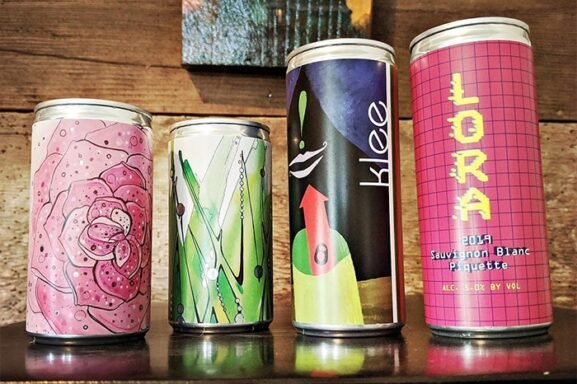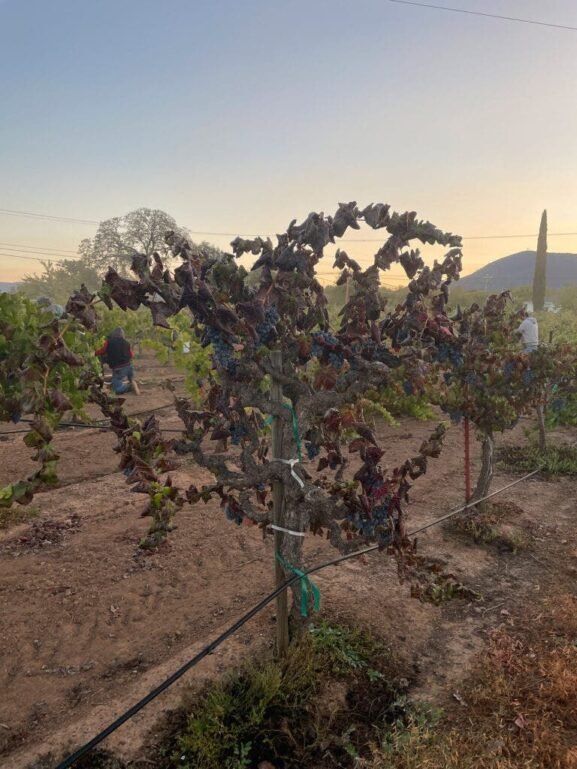Lambrusco vs. Moscato: A Battle of Italian Bubblies
One word perfectly encapsulates Lambrusco and Moscato: ebullience. Both Italian wines are sparkling, yes, but also boast a cheerful, bubbly vibe—easy-to-drink, fizzy, light, energetic, not too serious for a picnic or post-dinner treat. There’s no pomp and circumstance to popping a bottle of Lambrusco or Moscato. They’re just fun to drink.
“Both are lightly spritzed (or frizzante, as the Italians say), low in alcohol, served chilled and perfect for the patio,” says Emma Higgins, sommelier at Uvae Kitchen & Wine Bar in Chicago.
Energy aside, the wine styles do have their differences. Lambrusco is traditionally deep ruby, made in the Emilia-Romagna region of Italy. Moscato was born in the North, Piedmont, where it’s traditionally made from grapes from the Muscat family including Muscat Blanc à Petits Grains, Muscat of Alexandria and Muscat Ottonel.
“Moscato is a simple, fresh, bright and delightfully sweet aperitif,” continues Higgins. “Lambrusco is chic—pink to deep purple. It’s like Moscato’s cool cousin who visits on holidays.”
What else defines the two iconic Italian sparklers? Below, sommeliers weigh in.
The Grapes: Wild Reds vs. Aromatic Whites
Lambrusco is typically made from grapes in the Lambrusco family, most notably Lambrusco di Sorbara, Lambrusco Maestri, Lambrusco Salamino and Lambrusco Grasparossa. Each one shines in different soils and offers their own nuances and personality to Lambrusco.
Lambrusco can range from lightly pink to almost black in color, with high notes of wild cherry and plum. But there are regional differences to the wines. “Lambrusco hailing from Emilia-Romagna has a little more serious of a vibe, especially when it comes to food pairing,” says Daniel Cools, the beverage director at Juniper & Ivy in San Diego.
Adding to the food-friendliness is the fact that these grapes are often used in the production of balsamic vinegar, too, which interestingly shows up in the wine. “Lambrusco tends to showcase notes of balsamic, violet and strawberry,” notes sommelier Katie Forstner of Salt Lake City’s Urban Hill, a 2024 James Beard Award nominee.
// Create the element
var script_685c4555512e7 = document.createElement(“script”);
script_685c4555512e7.innerHTML = `
window.googletag = window.googletag || {cmd: []};
googletag.cmd.push(function() {
var adType = “leaderboard”;
var mapping;
var lbmapping = googletag.sizeMapping()
.addSize([1024, 0], [[970, 250], [970, 90], [1, 1], [728, 90]])
.addSize([728, 0], [[728, 90], [1, 1]])
.addSize([320, 0], [[1, 1], [300, 50], [300, 100], [320, 50], [320, 100]])
.addSize([0, 0], [[1, 1], [320, 50]])
.build();; // Size mapping for leaderboard ads
var medrecmapping = googletag.sizeMapping()
.addSize([1024, 0], [[300, 600],[300, 250]])
.addSize([728, 0], [300, 250])
.addSize([320, 0], [[1, 1],[300, 250]])
.addSize([0, 0], [[1, 1], [300, 250]])
.build(); // Size mapping for med rectengle ads
if(‘/39808611/article_page/article_leaderboard_1’ == ‘/39808611/article_page/article_leaderboard_1’
|| ‘/39808611/article_page/article_leaderboard_1’ == ‘/39808611/article_page/article_leaderboard_2’
|| ‘/39808611/article_page/article_leaderboard_1’ == ‘/39808611/article_page/article_leaderboard_3’) {
mapping = googletag.sizeMapping()
.addSize([1920, 0], [[728, 90]]) // >= 1920px
.addSize([1440, 0], [[728, 90]]) // 1440px-1919px
.addSize([730, 0], [[300, 250]]) // 730px-1439px
.addSize([0, 0], [[320, 100], [320, 50], [300, 100], [300, 50], [300, 250]]) // Up to 729px
.build();
} else {
mapping = adType == ‘leaderboard’ ? lbmapping : medrecmapping;
}
googletag.defineSlot(‘/39808611/article_page/article_leaderboard_1’, [],
‘div-gpt-ad-685c4555512e7’).addService(googletag.pubads()).defineSizeMapping(mapping);
googletag.pubads().enableSingleRequest();
googletag.pubads().collapseEmptyDivs();
googletag.display(‘div-gpt-ad-685c4555512e7’);
});
`;
// Append the script to the body
document.body.appendChild(script_685c4555512e7);
Though the flavor profile is drastically different, Moscato is similarly born from grapes in the Muscat family. “Muscat Blanc, the grape of choice for Moscato, is one of the oldest and most aromatic varieties in the world,” says Forstner. (Of note, Muscat is also made into sweet and dry styles of still wine, though in this case Lambrusco is duking it out against the sparkling versions of Muscat, like Moscato d’Asti.)
“It can be dry if intended to be made as such, but most options tend to go from sweet to intensely sweet, with flavors that lean more toward the uncomplicated white grape, stone fruit and tropical fruit realm,” says Cools.
It’s also highly sessionable. “Moscato d’Asti, the most popular style, typically has an abv of below 5.5%—about a third of the alcohol of a normal glass of wine.”
Forstner sums up the differences with a fashion metaphor. “Lambrusco is Schiaparelli: avant-garde, unconventional and a true it-girl with a deep history of short-lived moments in the spotlight,” says Forstner. “Moscato, on the other hand, drips with the classic veneer of Chanel: clean and stylized, with a tendency to lean towards the saccharine.”
The Regions: Misty vs. Mediterranean
Just as the grapes represent opposite ends of the spectrum, so, too, do the growing regions.
Let’s start with Lambrusco. It hails from Emilia-Romagna and Lombardy, two areas that are influenced by the Mediterranean winds.
“Lambrusco has been made here since the Etruscan era, who were the first to vinify vitis Lambrusca in Italy,” says David Orellana, beverage director at Grand Brasserie in New York City. In recent years, it’s become a quintessential “pizza wine” the world over—with the crisp, ruby bubbles quenching the palate after bites of gooey cheese or red sauce.
You can also take Lambrusco more seriously, depending on the style it’s made in. “Lambrusco can range from bone dry to treacly, slightly bubbly to full-on fizzy, bright white to inky purple,” says Jeff Porter, Wine Enthusiast’s resident Italian reviewer.
Speaking generally, Lambrusco made in the Charmat method will give way to bigger, fruitier bubbles while ancestral method Lambrusco has more earthy, savory characteristics.
On the other hand, Italian Moscato’s lighter, more refreshing style can be attributed to the cool nights and misty mornings of its home in Piedmont—the same place from which Barolo comes.
Like Lambrusco (and for that matter Barolo), Moscato is equally historic. “Muscat Blanc is one of the oldest grapes in the world,” says Orellana. “In Piedmont, planting Moscato dates back to the 1300s.”
Today’s iterations of the lightly sparkling wine are buoyant, singing with floral notes of white peach, magnolia and green apple.
The Verdict: Lambrusco Is the Toast of the Town
So, which sparkler reigns supreme in the big battle of Italian bubbles?
Most industry pros point to the complex red bubbly that is in the midst of a global resurgence right now.
“I would have to say Lambrusco is my favorite of the two especially with Italian food,” says Alex Cooke, senior market chef at Buca di Beppo. “Whether it’s Lambrusco’s ability to cut through the richness of fresh prosciutto, or the light effervescence that cleanses the palate after a heaping bite of spicy shrimp fra diavolo, the versatility of this grape is endless.”
// Create the element
var script_685c455551c07 = document.createElement(“script”);
script_685c455551c07.innerHTML = `
window.googletag = window.googletag || {cmd: []};
googletag.cmd.push(function() {
var adType = “leaderboard”;
var mapping;
var lbmapping = googletag.sizeMapping()
.addSize([1024, 0], [[970, 250], [970, 90], [1, 1], [728, 90]])
.addSize([728, 0], [[728, 90], [1, 1]])
.addSize([320, 0], [[1, 1], [300, 50], [300, 100], [320, 50], [320, 100]])
.addSize([0, 0], [[1, 1], [320, 50]])
.build();; // Size mapping for leaderboard ads
var medrecmapping = googletag.sizeMapping()
.addSize([1024, 0], [[300, 600],[300, 250]])
.addSize([728, 0], [300, 250])
.addSize([320, 0], [[1, 1],[300, 250]])
.addSize([0, 0], [[1, 1], [300, 250]])
.build(); // Size mapping for med rectengle ads
if(‘/39808611/article_page/article_leaderboard_2’ == ‘/39808611/article_page/article_leaderboard_1’
|| ‘/39808611/article_page/article_leaderboard_2’ == ‘/39808611/article_page/article_leaderboard_2’
|| ‘/39808611/article_page/article_leaderboard_2’ == ‘/39808611/article_page/article_leaderboard_3’) {
mapping = googletag.sizeMapping()
.addSize([1920, 0], [[728, 90]]) // >= 1920px
.addSize([1440, 0], [[728, 90]]) // 1440px-1919px
.addSize([730, 0], [[300, 250]]) // 730px-1439px
.addSize([0, 0], [[320, 100], [320, 50], [300, 100], [300, 50], [300, 250]]) // Up to 729px
.build();
} else {
mapping = adType == ‘leaderboard’ ? lbmapping : medrecmapping;
}
googletag.defineSlot(‘/39808611/article_page/article_leaderboard_2’, [],
‘div-gpt-ad-685c455551c07’).addService(googletag.pubads()).defineSizeMapping(mapping);
googletag.pubads().enableSingleRequest();
googletag.pubads().collapseEmptyDivs();
googletag.display(‘div-gpt-ad-685c455551c07’);
});
`;
// Append the script to the body
document.body.appendChild(script_685c455551c07);
Orellana feels the same way, highlighting the wide breadth of styles and aromas that make it a versatile partner at the dinner table. “It’s a food-friendly wine that has the bandwidth to pair well with rich and light dishes alike,” he says. “Lambrusco is all about flavor, which depends on the vinification process, whether the wine was made with the charmat or ancestral method, or if it was vinified to a particular sweetness level style.”
Higgins goes even further. She calls out its ability to span the year, from fueling warm weather occasions to pairing seamlessly with Thanksgiving turkey or holiday desserts. In fact, one could easily argue she’s a superfan of the sparkler. “I love Lambrusco,” she says. “No two bottles are exactly the same, which cannot be said for Moscato. It’s a beautiful color and a wonderfully unique wine. Also, it’s been my wifi password since 2022. If you’re a guest who needs the internet, you’re subject to this same lecture!”
There you have it—we actually have a winner. (Sorry, Moscato!)
More Greatest Grape Debates
- Clean and consistent or frisky and feral: sparkling wine and pét nat square off.
- And how does Sauvignon Blanc compete against Chardonnay? We investigate.
- There’s also this battle of the easy-going white wines: Pinot Grigio vs. Sauvignon Blanc.
- Then we have the big reds: Merlot vs. Malbec.
- And Barolo vs. Brunello: which Italian red reigns supreme?
From the Shop
Find Your Wine a Home
Our selection of white wine glasses is the best way to enjoy the wine’s subtle aromas and bright flavors.
The post Lambrusco vs. Moscato: A Battle of Italian Bubblies appeared first on Wine Enthusiast.


